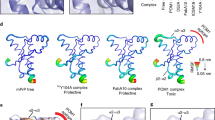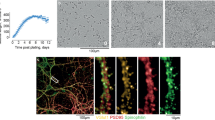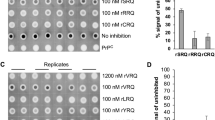Abstract
Prions are the transmissible pathogenic agents responsible for diseases such as scrapie and bovine spongiform encephalopathy. In the favoured model of prion replication, direct interaction between the pathogenic prion protein (PrPSc) template and endogenous cellular prion protein (PrPC) is proposed to drive the formation of nascent infectious prions1,2. Reagents specifically binding either prion-protein conformer may interrupt prion production by inhibiting this interaction. We examined the ability of several recombinant antibody antigen-binding fragments (Fabs) to inhibit prion propagation in cultured mouse neuroblastoma cells (ScN2a) infected with PrPSc. Here we show that antibodies binding cell-surface PrPC inhibit PrPSc formation in a dose-dependent manner. In cells treated with the most potent antibody, Fab D18, prion replication is abolished and pre-existing PrPSc is rapidly cleared, suggesting that this antibody may cure established infection. The potent activity of Fab D18 is associated with its ability to better recognize the total population of PrPC molecules on the cell surface, and with the location of its epitope on PrPC. Our observations support the use of antibodies in the prevention and treatment of prion diseases and identify a region of PrPC for drug targeting.
This is a preview of subscription content, access via your institution
Access options
Subscribe to this journal
Receive 51 print issues and online access
$199.00 per year
only $3.90 per issue
Buy this article
- Purchase on Springer Link
- Instant access to full article PDF
Prices may be subject to local taxes which are calculated during checkout




Similar content being viewed by others
References
Telling, G. C. et al. Evidence for the conformation of the pathologic isoform of the prion protein enciphering and propagating prion diversity. Science 274, 2079–2082 (1996).
Prusiner, S. B. Prions. Proc. Natl Acad. Sci. USA 95, 13363–13383 (1998).
Williamson, R. A. et al. Circumventing tolerance in order to generate autologous monoclonal antibodies to the prion protein. Proc. Natl Acad. Sci. USA 93, 7279–7282 (1996).
Peretz, D. et al. A conformational transition at the N-terminus of the prion protein features in formation of the scrapie isoform. J. Mol. Biol. 273, 614–622 (1997).
Williamson, R. A. et al. Mapping the prion protein using recombinant antibodies. J. Virol. 72, 9413–9418 (1998).
Leclerc, E. et al. Immobilized prion protein undergoes spontaneous rearrangement to a conformation having features in common with the infectious form. EMBO J. 20, 1574–1554 (2001).
Chuong, C.-M., McClain, D. A., Streit, P. & Edelman, G. M. Neural cell adhesion molecules in rodent brains isolated by monoclonal antibodies with cross-species reactivity. Proc. Natl Acad. Sci. USA 79, 4234–4238 (1982).
Butler, D. A. et al. Scrapie-infected murine neuroblastoma cells produce protease-resistant prion proteins. J. Virol. 62, 1558–1564 (1988).
Caughey, B. & Raymond, G. J. Sulfated polyanion inhibition of scrapie-associated PrP accumulation in cultured cells. J. Virol. 67, 643–650 (1993).
Chabry, J. et al. Species-independent inhibition of abnormal prion protein (PrP) formation by a peptide containing a conserved PrP sequence. J. Virol. 73, 6245–6250 (1999).
Perrier, V. et al. Mimicking dominant negative inhibition of prion replication through structure-based drug design. Proc. Natl Acad. Sci. USA 97, 6073–6078 (2000).
Caughey, W. S., Raymond, L. D., Horiuchi, M. & Caughey, B. Inhibition of protease-resistant prion protein formation by porphyrins and phthalocyanines. Proc. Natl Acad. Sci. USA 95, 12117–12122 (1998).
Supattapone, S., Nguyen, H. O., Cohen, F. E., Prusiner, S. B. & Scott, M. R. Elimination of prions by branched polyamines and implications for therapeutics. Proc. Natl Acad. Sci. USA 96, 14529–14534 (1999).
Borchelt, D. R., Scott, M., Taraboulos, A., Stahl, N. & Prusiner, S. B. Scrapie and cellular prion proteins differ in their kinetics of synthesis and topology in cultured cells. J. Cell Biol. 110, 743–752 (1990).
Kaneko, K. et al. Evidence for protein X binding to a discontinuous epitope on the cellular prion protein during scrapie prion propagation. Proc. Natl Acad. Sci. USA 94, 10069–10074 (1998).
Zulianello, L. et al. Dominant-negative inhibition of prion formation diminished by deletion mutagenesis of the prion protein. J. Virol. 74, 4351–4360 (2000).
Scott, M. et al. Propagation of prions with artificial properties in transgenic mice expressing chimeric PrP genes. Cell 73, 979–988 (1993).
Priola, S. A. & Chesebro, B. A single hamster PrP amino acid blocks conversion to protease-resistant PrP in scrapie-infected mouse neuroblastoma cells. J. Virol. 69, 7754–7758 (1995).
Kocisko, D. A. et al. Species specificity in the cell-free conversion of prion protein to protease-resistant forms: A model for the scrapie species barrier. Proc. Natl Acad. Sci. USA 92, 3923–3927 (1995).
Priola, S. A., Chabry, J. & Chan, K. Efficient conversion of normal prion protein (PrP) by abnormal hamster PrP is determined by homology at amino acid residue 155. J. Virol. 75, 4673–4680 (2001).
Supattapone, S. et al. Prion protein of 106 residues creates an artificial transmission barrier for prion replication in transgenic mice. Cell 96, 869–878 (1999).
Xu, D. et al. In vitro characterization of five humanized OKT3 effector function variant antibodies. Cell. Immunol. 200, 16–26 (2000).
Idusogie, E. E. et al. Mapping of the C1q binding site on rituxan, a chimeric antibody with a human IgG1 Fc. J. Immunol. 164, 4178–4184 (2000).
Schenk, D. et al. Immunization with amyloid-β attenuates Alzheimer-disease-like pathology in the PDAPP mouse. Nature 400, 173–177 (1999).
Bard, F. et al. Peripherally administered antibodies against amyloid β-peptide enter the central nervous system and reduce pathology in a mouse model of Alzheimer disease. Nature Med. 6, 916–919 (2000).
Race, R. E., Fadness, L. H. & Chesebro, B. Characterization of scrapie infection in mouse neuroblastoma cells. J. Gen. Virol. 68, 1391–1399 (1987).
James, T. L. et al. Solution structure of a 142-residue recombinant prion protein corresponding to the infectious fragment of the scrapie isoform. Proc. Natl Acad. Sci. USA 94, 10086–10091 (1997).
Rudd, P. M., Wormald, M. R., Wing, D. R., Prusiner, S. B. & Dwek, R. A. Prion glycoprotein: Structure, dynamics, and roles for the sugars. Biochemistry 40, 3759–3766 (2001).
Petrescu, A. J., Petrescu, S. M., Dwek, R. A. & Wormald, M. R. A statistical analysis of N- and O-glycan linkage conformations from crystallographic data. Glycobiology 9, 343–352 (1999).
Acknowledgements
We thank J. Safar, S. DeArmond, F. Cohen and P. Dazin for discussions and K. Crossin for anti-N-CAM antibody. This work was supported by grants from the National Institutes of Health to R.A.W., D.R.B. and S.B.P.
Author information
Authors and Affiliations
Corresponding author
Supplementary information

Figure 5
(JPG 26.2 KB)
Levels of PrPC in antibody-treated ScN2a cells determined by immunoblot. ScN2a cultures were treated for a period of 7 days with 10 mg/ml of Fabs D13, D18, R72, R1, R2, E123 or E149, or passaged in the absence of antibody.

Figure 6
(JPG 35.4 KB)
PrP-specific antibody Fab binding to the surface of ScN2a cells. The reactivity of PrP-specific Fabs D13, D18, R72, R1 and R2 with the surface of ScN2a cells was evaluated using flow cytometry. The data represent the mean of three experiments.
Rights and permissions
About this article
Cite this article
Peretz, D., Williamson, R., Kaneko, K. et al. Antibodies inhibit prion propagation and clear cell cultures of prion infectivity. Nature 412, 739–743 (2001). https://doi.org/10.1038/35089090
Received:
Accepted:
Issue Date:
DOI: https://doi.org/10.1038/35089090
This article is cited by
-
Large animal models for chronic wasting disease
Cell and Tissue Research (2023)
-
Vaccines for prion diseases: a realistic goal?
Cell and Tissue Research (2023)
-
Mechanisms of prion-induced toxicity
Cell and Tissue Research (2023)
-
A high-content neuron imaging assay demonstrates inhibition of prion disease-associated neurotoxicity by an anti-prion protein antibody
Scientific Reports (2022)
-
Scaling analysis reveals the mechanism and rates of prion replication in vivo
Nature Structural & Molecular Biology (2021)
Comments
By submitting a comment you agree to abide by our Terms and Community Guidelines. If you find something abusive or that does not comply with our terms or guidelines please flag it as inappropriate.



